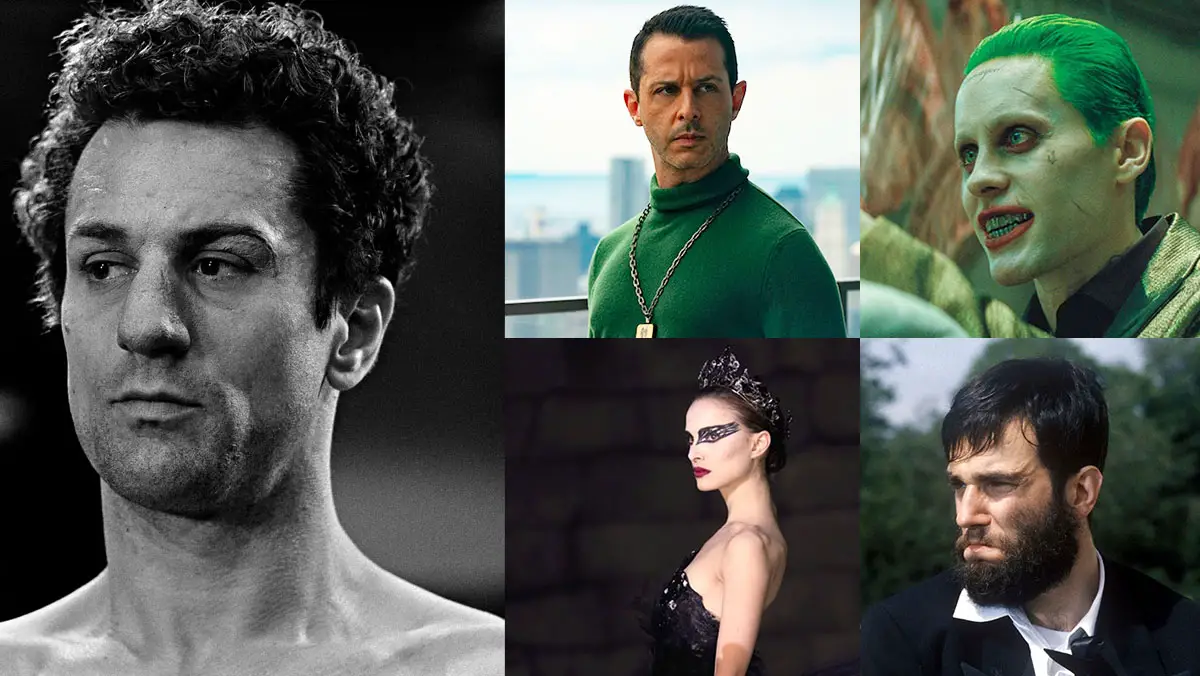What is Method Acting?
Method Acting is Reality Acting
Some actors choose to stay in character for long periods of time and exhibit the behavior of a character even when not performing. They may conduct extensive research in order to understand a character. Well known famous method actors and examples are: Academy Award winner Robert De Niro gaining weight for his character Jake LaMotta in Raging Bull, Daniel Day Lewis staying in character for the duration of filming My Left Foot, Natalie Portman taking ballet lessons before filming Black Swan, and Jared Leto in Moribus or pulling pranks on the cast and crew of Suicide Squad or going deep into character while playing the role of the Joker or Jeremy Strong famously annoying Brian Cox while on the set of Succession. Because Method acting is a technique, the choices these actors made may have helped them in some manner, but these types of choices are in no way associated with the Method.
The Method Acting definition or meaning, is really reality acting. When using the Method, the actor uses his imagination or something from his own life in order to create the inner life of his character. Conducting research, staying in character for extended periods of time or making a physical adjustment does not make you a Method actor. The degree to which you do anything in order to get into character and make your performance real is a personal choice that is not tied to Method acting.
The Actor is Always the Character
They Do Not Get “Lost” in the Character
Konstantin Stanislavski was the first person to explore the idea that sense memory could help the actor create believable behavior on stage. This is known as the Stanislavski System. Lee Strasberg (who founded the Group Theatre in New York City and also went on to become director of the famed Actors Studio) studied Stanislavski’s work. The Lee Strasberg Method is an extension of the Stanislavski System. Strasberg developed a series of exercises for the actor that help him train his power of concentration, be expressive and create his character’s reality. Some of the exercises are known as sense memory, animal, private moment and emotional memory. Once an actor learns and masters the exercises, he is then able to use the exercises to explore and create a character.
The Lee Strasberg Method exercises are designed to be used in the classroom and in performance. Relaxation and concentration are the foundation of the Stanislavsky system and the Lee Strasberg Method. An actor cannot be expressive if he is not relaxed and concentrated. (“Concentrated” is acting jargon for focused.) Emotion cannot get in or out of the body if the actor is tense. The actor cannot take on the details of his character’s world if he is not concentrated. The beginning exercises help a new actor free his body of tension, hone his ability to concentrate for extended periods of time and become self-aware. After studying intensively for about 2 years, the actor is able to delve into his own experiences, thoughts and feelings and effectively use them, in an artistic way, in order to bring a character to life. The actor is always the character. He does not get “lost” in the character. He is always in control of his behavior. A small part of him always knows that he is acting. A trained Method actor is capable of creating the behavior he feels is right for the character and dropping the behavior when he is not acting. After about 10 years of studying the Method, the actor has a deep understanding of the Method and is in a position to use the technique to its full capacity and in the way it was designed to be used. One of the many important skills a Method actor learns is how to get in and out of character without getting “lost.”
“If it’s literal, where is the craft of acting?” – Lee Strasberg
Lee Strasberg never wrote or said that part of the Method work was to “lose” oneself in his character. He never advocated that one should stay in character for extended periods of time in order to get better results. Lee never advised an actor to do anything that is potentially dangerous, harmful or destructive to himself in order get better results. Lee never instructed an actor to do anything that may endanger or harm another actor or person in order to get better results. A Method actor may conduct research in order to understand his character’s mindset or physicality. The research is conducted in a controlled, healthy and responsible manner.
A trained Method actor must be willing to deal and be capable of dealing with the most intense and difficult aspects of his own psychology and experiences. However, the Method is not therapy. The exercises are not for the purpose of coming to terms with the past or “finding closure.” Method work is solely for the use of artistic expression.
Creativity comes from experience, imagination and observation. A great artist becomes inspired and expresses a truth about the human condition and the world in which he lives. One of the main challenges for any artist is finding a way to harness inspiration. The Method when used as Lee Strasberg designed it, without fail, inspires creativity. The challenge of igniting the creative spirit at will was one of the main impetuses for Stanislavski’s development of his System. In turn, Strasberg strove to solve the actor’s problem of being able to get in and out of character at will for a long stage run or multiple film takes. In the course of his study, the Method actor is taught to get into character within about three minutes and get out of character within about five minutes. If a trained Method actor has trouble getting out of character and it is affecting his life negatively, then the Method is not right for him.
How does this apply to you, the actor? The Method helps you create the real behavior of a character. If you are playing a heroin addict, you do not do heroin in order to get the behavior of an addict. You find something from your own life that you have experienced that is akin to what spawns the behavior of a heroin addict. If you play someone who gets shot, you do not need to experience getting shot in order to portray getting shot. If you are playing someone who is mentally unstable, you do not need to become mentally unstable in order to give a great performance. Lee Strasberg wrote, “if it’s literal, where is the craft of acting?”
If You Are Playing Lady Macbeth,
You Do Not Need to Inspire Your Real Life Husband
to Commit Murder For the Purpose of
Creating Your Character
Each character you play has his own unique inner life and given circumstances. While it’s impossible to define what constitutes “safe research” and “responsible conduct” before, during and after a performance, it is safe to say that if you are playing Lady Macbeth, you do not need to inspire your husband in real life to commit murder for the purpose of creating your character.
Acting is performing. Acting is finding yourself in the character. Acting is creating a character’s reality. Acting is using your imagination. An actor may make a slight or extreme transformation in order to get into character, but he is always conscious of the fact that he is acting. He never gets “lost.”





